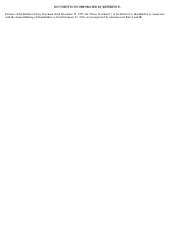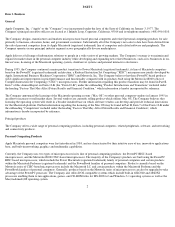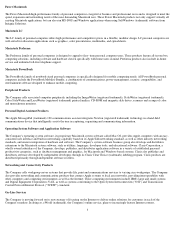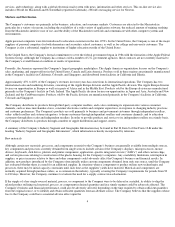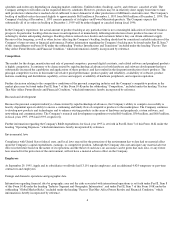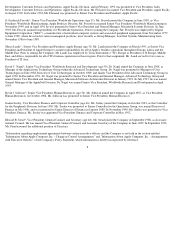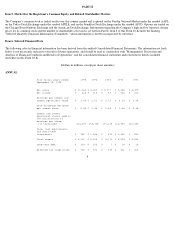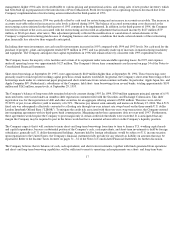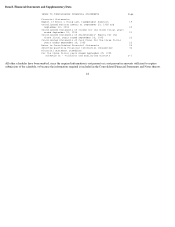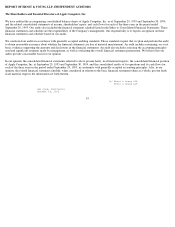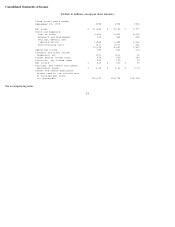Apple 1995 Annual Report Download - page 13
Download and view the complete annual report
Please find page 13 of the 1995 Apple annual report below. You can navigate through the pages in the report by either clicking on the pages listed below, or by using the keyword search tool below to find specific information within the annual report.In the Company's experience, the actual amount of product backlog at any particular time is not a meaningful indication of its future business
prospects. In particular, backlog often increases in anticipation of or immediately following introduction of new products because of
overordering by dealers anticipating shortages. Backlog often is reduced once dealers and customers believe they can obtain sufficient supply.
Because of the foregoing, as well as other factors affecting the Company's backlog, backlog should not be considered a reliable indicator of the
Company's future revenue or financial performance. For further information regarding the Company's backlog, refer to page 13 of
Management's Discussion and Analysis of Financial Condition and Results of Operations under the heading "Factors That May Affect Future
Results and Financial Condition."
Gross Margin
Gross margin represents the difference between the Company's net sales and its cost of goods sold. The amount of revenue generated by the
sale of products is influenced principally by the price set by the Company for its products relative to competitive products. The cost of goods
sold is based primarily on the cost of components and, to a lesser extent, direct labor costs. The type and cost of components included in
particular configurations of the Company's products (such as memory and disk drives) are often directly related to the need to market products
in configurations competitive with those of other manufacturers. Competition in the personal computer industry is intense, and in the short
term, frequent changes in pricing and product configuration are often necessary in order to remain competitive. Accordingly, gross margin as a
percentage of net sales can be significantly influenced in the short term by actions undertaken by the Company in response to industrywide
competitive pressures.
Gross margin increased both in amount and as a percentage of net sales in 1995 compared with 1994. The increase in gross margin as a
percentage of net sales was primarily a result of a shift in product mix toward the Company's newer, high-margin products, which included
strong sales of certain products within the Company's Power Macintosh family of personal computers and its entry-level Macintosh Performa
family.
The increase in gross margin levels was affected favorably by changes in foreign currency exchange rates as a result of a weaker U.S. dollar
relative to certain foreign currencies in 1995 compared with 1994. The Company's operating strategy and pricing take into account changes in
exchange rates over time; however, the Company's results of operations can be significantly affected in the short term by fluctuations in foreign
currency exchange rates.
Gross margin in 1994 declined as a percentage of net sales from 1993 levels. The downward trend in gross margin as a percentage of net sales
was primarily a result of pricing and promotional actions undertaken by the Company in response to industrywide competitive pricing
pressures. Gross margin was also affected somewhat adversely by changes in foreign currency exchange rates as a result of a stronger U.S.
dollar relative to certain foreign currencies in 1994 compared with 1993. Results from the Company's ongoing foreign currency hedging
activities offset a portion of this adverse foreign currency impact on gross margin.
Although the Company's gross margin percentage was 25.8% in 1995, gross margin as a percentage of net sales declined to 20.7% in the fourth
quarter of 1995, primarily due to aggressive pricing actions and product mix issues related to component availability and delays in new
PowerPC processor-based product production. It is anticipated that gross margins will continue to remain under significant pressure and are
likely to remain comparable to the level reported for the fourth quarter of 1995 due to a variety of factors, including continued industrywide
pricing pressures, increased competition, particularly in Japan, and compressed product life cycles.
Research and Development
Research and development expenditures increased in amount during 1995 when compared with 1994, primarily due to higher project- and
headcount- related spending, as the Company continues to invest in the development of new products and technologies. The decrease in
research and development expenditures during 1994 compared with 1993 reflected the results of the Company's restructuring actions aimed at
reducing costs, including product development expenditures. Research and development expenditures as a percentage of net sales have
continued to decrease since 1993 as a result of revenue growth during 1994 and 1995, coupled with the Company's continuing efforts to focus
its research and development project spending in an efficient manner.
The Company believes that continued focused investment in research and development is critical to its future growth and competitive position
in the marketplace, and is directly related to continued, timely development of new and enhanced products.
Selling, General and Administrative
Selling, general and administrative expenses increased in amount, but decreased as a percentage of net sales, in 1995 compared with 1994. This
increase in expense was primarily a result of increased advertising and channel marketing program spending as the Company continued its
efforts to expand its market share. Although the Company has increased its selling and marketing expenses in an effort to expand its market
share, there can be no assurance that such an increase in spending will result in a corresponding
11


